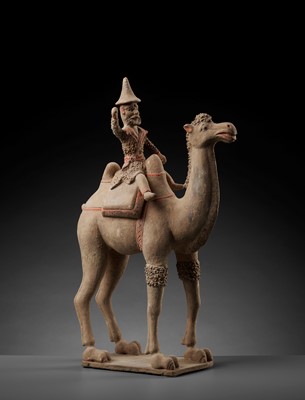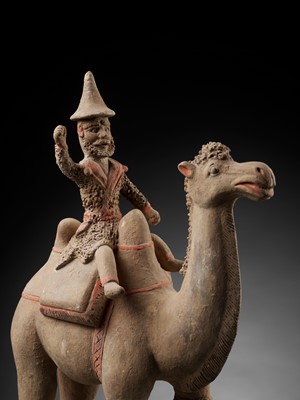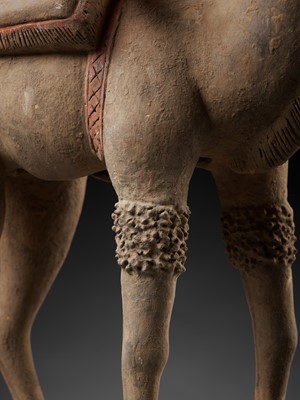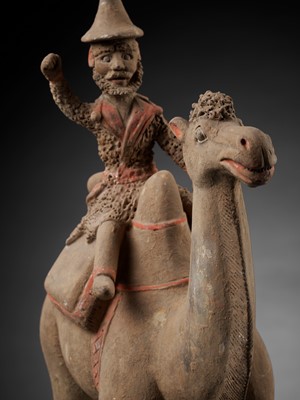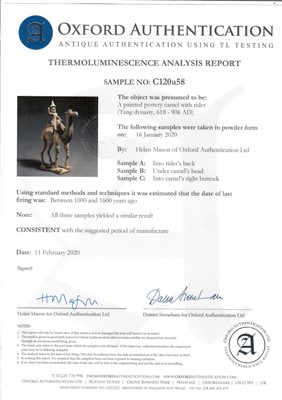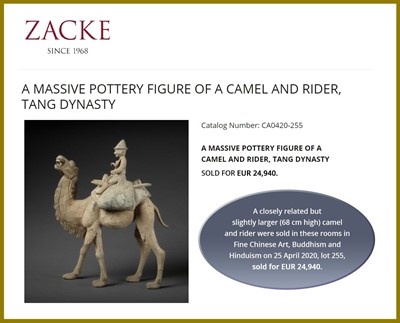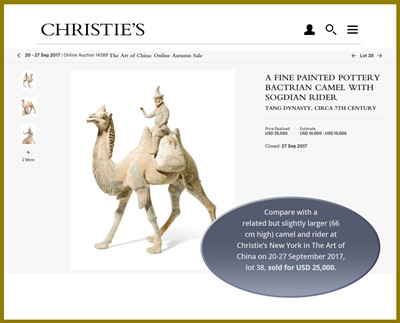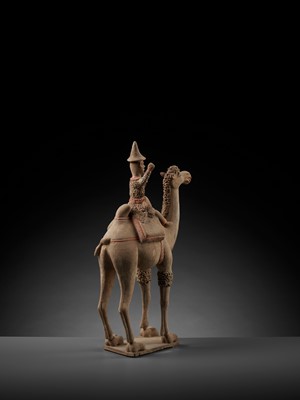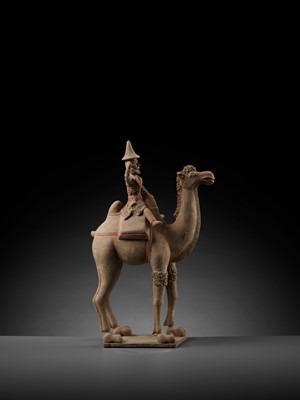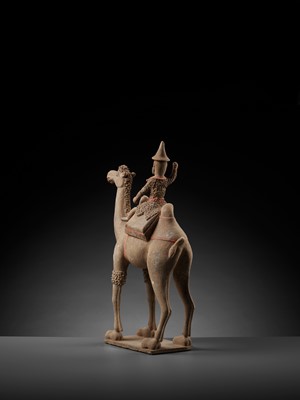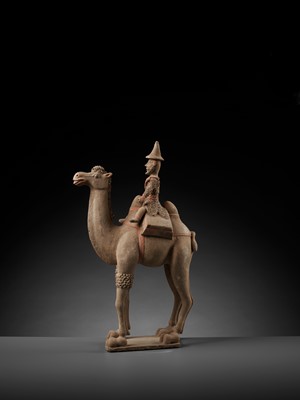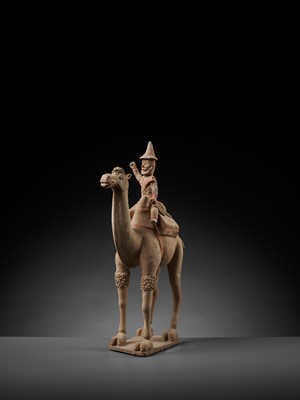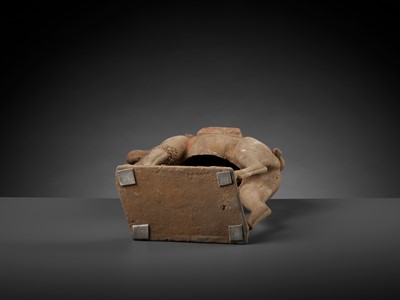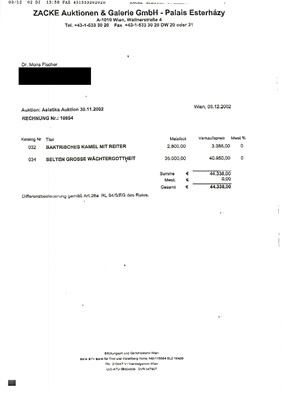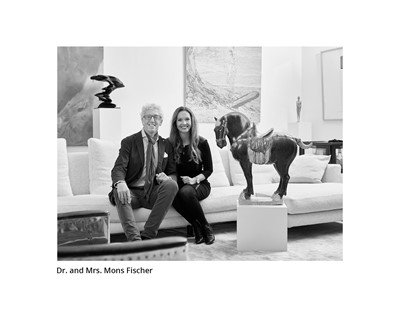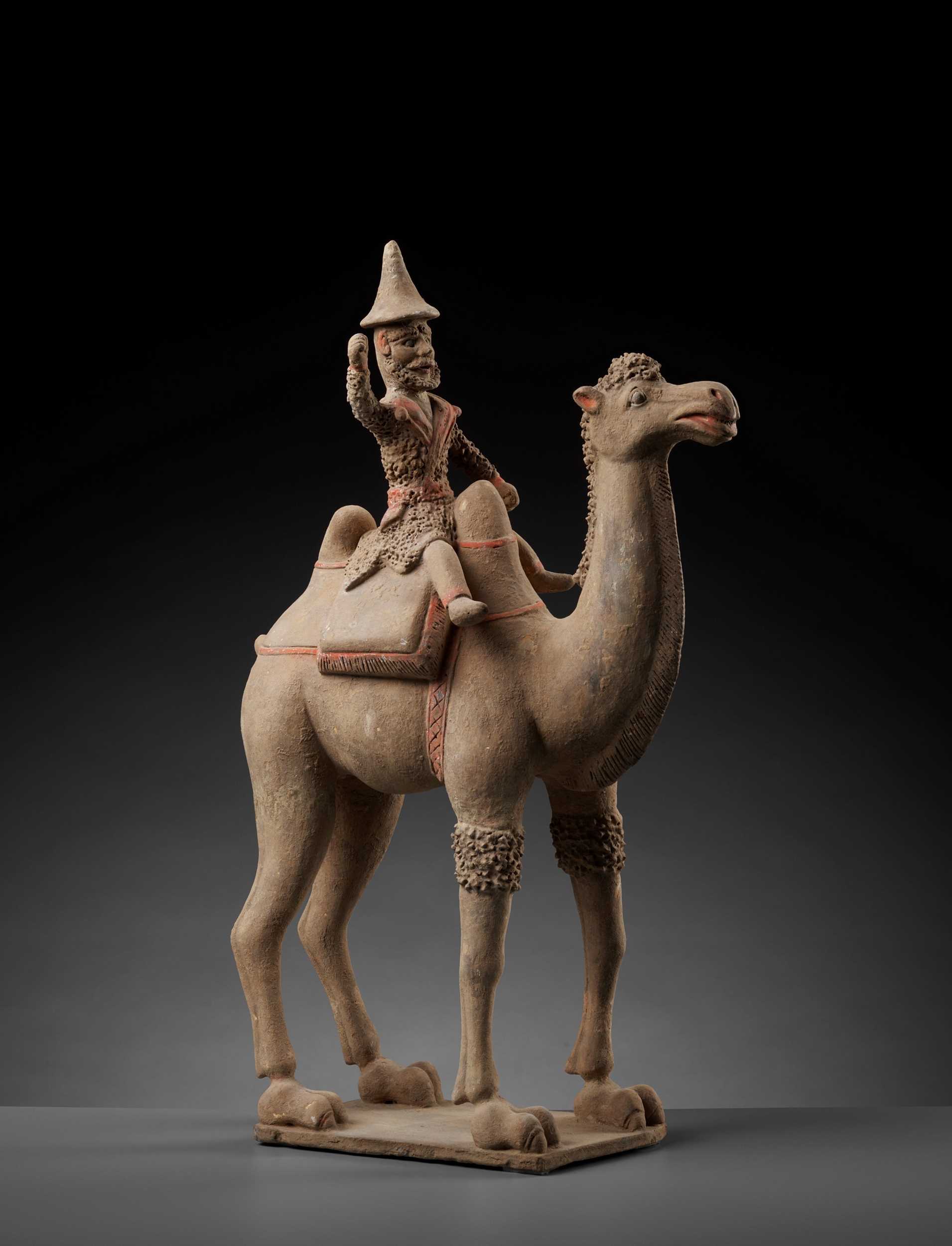5th Mar, 2021 10:00
TWO-DAY AUCTION - Fine Chinese Art / 中國藝術集珍 / Buddhism & Hinduism
137
A LARGE PAINTED POTTERY BACTRIAN CAMEL WITH RIDER, TANG DYNASTY
唐代大型彩繪胡人騎駝陶俑
Sold for €8,848
including Buyer's Premium
China, 618-907. The two-hump camel standing foursquare on a rectangular base, neck raised and mouth slightly open to reveal tongue and teeth above the hairy beard, the bearded Turk or Sogdian rider wearing a distinctive pointed hat and seated in a relaxed posture with his right arm raised to goad the camel, the other hand originally holding the reins.
Provenance: German private collection. Galerie Zacke, Vienna, 3 December 2002. Dr. Mons Fischer, acquired from the above. A copy of the original invoice from Galerie Zacke, Vienna, dated to 3 December 2002, accompanies this lot. A seasoned private collector of modern and contemporary art, Dr. Mons Fischer has also acquired fine Chinese works of art since the 1980s, eventually building one of the most important collections of its kind in Austria.
Condition: Some repair and touchups as generally expected from Tang dynasty excavations. Losses, fissures, and encrustations. Extensive wear to pigments. Drilled holes from sample-taking. Overall, very good condition.
Scientific analysis report: A thermoluminescence report issued by Oxford Authentication on 11 February 2020, based on sample no. C120a58, sets the firing date of all three samples taken at 1000 – 1600 years ago. A copy of the report, issued by Oxford Authentication, accompanies this lot.
Weight: 5.0 kg
Dimensions: Height 59.5 cm
The Tang dynasty is undoubtedly one of the most artistically exciting periods in China's long history. The arts are characterized by their diversity, cosmopolitan nature of their design, and by the high technical skill employed in their manufacture as the present pottery example amply demonstrates. In the first half of this dynasty, up to the An Lushan rebellion of 756, the level of luxury enjoyed by the court and the Tang elite ensured the production of a wide range of goods of the highest quality. China prospered as a result of trade with the west along the famous Silk Road, and camels became increasingly important for the transport of wares, since these impressive animals could carry heavy loads over long distances, surviving several days without water. As their large and broad feet did not sink easily into the sand, they became known as ‘the ships of the desert’. Many camels were imported from the states of the Tarim basin, Eastern Turkmenistan, and Mongolia, and are known as Bactrian camels. The Tang civil servants created a special office to supervise their breeding and services. It seems that no pottery examples showing Chinese riders have yet been excavated. Perhaps only these Central Asian foreigners were able to tame and guide the camels.
Handsome, imposing and exotic camels such as the present lot are of great scholarly importance as well as being highly decorative. Much of the evidence of Tang dynasty life comes from archaeological pieces from tomb excavations which bear witness to fear of death as well as a desire to recreate the lifestyle and comforts experienced in this life. Impressive beasts such as this camel, as well as horses and other figures including attendants, officials and servants, were therefore required to accompany the deceased on his journey in the afterlife. Examples of Tang dynasty camels, both unglazed and with sancai glaze, are in important museum collections including the British Museum, Musée Guimet, and the Metropolitan Museum of Art.
Literature comparison: For a comparable figure of a camel with Central Asian rider see Hao Qian, et al., Out of China's Earth: Archaeological Discoveries in the People's Republic of China, Beijing 1981, fig.241. For another related group of gray pottery camels excavated from the tomb of Dugu Sijing, dated AD 709, see Tang Chang'an chengjiao Sui Tang mu (Excavation of the Sui and Tang Tombs at Xi'an), Bejing, 1980, pls.65, 70-71.
Auction result comparison: A closely related but slightly larger (68 cm high) camel and rider were sold in these rooms in Fine Chinese Art, Buddhism and Hinduism on 25 April 2020, lot 255, sold for EUR 24,940. Compare also with a related but slightly larger (66 cm high) camel and rider at Christie’s New York in The Art of China on 20-27 September 2017, lot 38, sold for USD 25,000.
唐代大型彩繪胡人騎駝陶俑
中國, 618-907年。雙峰四足前後錯落站立在菱形托板上,昂首引頸,作嘶鳴狀。駝背上坐一胡人,深目高鼻,絡腮鬍。頭戴尖帽,身著翻領、窄袖、開胯、過膝的胡服。手扶駱駝前肉峰。
來源:德國私人收藏。維也納 Zacke藝廊, 2002年12月3日。 Mons Fischer博士購於上述藝廊。隨附發票副本。Mons Fischer博士是一位經驗豐富的現代和當代藝術私人收藏家,從1980年代開始收藏中國藝術品,最終成爲奧地利中國藝術品重要收藏之一。
圖片:Dr. Mons Fischer 和他的妻子
品相:唐朝出土物品預期的一些維修。缺損、裂縫和結殼。顏料大量磨損。 因檢測樣品採集鑽孔。 總體而言,狀況良好。
科學檢測報告: 隨附一份2020年2月11日出具的牛津熱釋光檢測報告副本, 采樣編號C120a58。檢測結果表明拍品為1000-1600年前所制。
重量:5.0 公斤
尺寸:高59.5 厘米
唐朝無疑是中國歷史長河上最令人激動的藝術時期之一。如本拍品實例充分表現的那樣,藝術的特徵在於多樣性、設計的國際化以及其製造中採用的高技術。從唐初到756年的安祿山叛亂,宮廷和唐朝精英階層享有的富裕水平確保了各種最高品質商品的生產。絲綢之路更是擴大了與西方的貿易,中國繁榮了,駱駝在商品運輸中變得越來越重要,因為這動物可以長途搬運重物,無水生存數天。由於它們大而寬的腳不易沉入沙灘,因此被稱為“沙漠之船”。許多駱駝是從塔里木盆地、土庫曼斯坦東部和蒙古進口的,被稱為雙峰駝。唐代甚至建立了一個專門官署,監督其繁殖和運作。目前似乎還沒有發掘出顯示中國駝俑的實例。也許只有這些中亞人才能馴服和引導駱駝。
像現在這樣雄壯的、充滿異國情調的例如此拍品中的駱駝不但在學術上舉足輕重,裝飾性也很高。 重現唐朝生活需要很多來自出土的物品,這些出土物見證了古時人們對死亡的恐懼以及渴望重塑這一生所經歷的舒適的生活的願望。 因此,像這樣令人印象深刻的野獸比如駱駝,以及包括侍者以及官員、馬等都陶器都會用來陪葬。 重要的博物館收藏了很多上釉、位上釉和三彩的唐朝駱駝,比如大英博物館、吉梅博物館和大都會博物館。
文獻比較:一件胡人駱駝陶俑見 Hao Qian, et al., Out of China's Earth: Archaeological Discoveries in the People's Republic of China, Beijing 1981, fig.241.;另一組灰陶駱駝見獨孤思敬墓(公元709年),《唐長安城郊隋唐墓》,北京1980年,圖65, 70-71。
拍賣結果比較:一件非常相似但更大 (高68 厘米)的胡人駱駝見本拍賣行Fine Chinese Art, Buddhism and Hinduism 拍場2020年4月25日 lot 255, 售價EUR 24,940. ;一件相近但更大 (高66 厘米)的胡人駱駝見紐約佳士得The Art of China 拍場2017年9月20-27日 lot 38, 售價USD 25,000.
China, 618-907. The two-hump camel standing foursquare on a rectangular base, neck raised and mouth slightly open to reveal tongue and teeth above the hairy beard, the bearded Turk or Sogdian rider wearing a distinctive pointed hat and seated in a relaxed posture with his right arm raised to goad the camel, the other hand originally holding the reins.
Provenance: German private collection. Galerie Zacke, Vienna, 3 December 2002. Dr. Mons Fischer, acquired from the above. A copy of the original invoice from Galerie Zacke, Vienna, dated to 3 December 2002, accompanies this lot. A seasoned private collector of modern and contemporary art, Dr. Mons Fischer has also acquired fine Chinese works of art since the 1980s, eventually building one of the most important collections of its kind in Austria.
Condition: Some repair and touchups as generally expected from Tang dynasty excavations. Losses, fissures, and encrustations. Extensive wear to pigments. Drilled holes from sample-taking. Overall, very good condition.
Scientific analysis report: A thermoluminescence report issued by Oxford Authentication on 11 February 2020, based on sample no. C120a58, sets the firing date of all three samples taken at 1000 – 1600 years ago. A copy of the report, issued by Oxford Authentication, accompanies this lot.
Weight: 5.0 kg
Dimensions: Height 59.5 cm
The Tang dynasty is undoubtedly one of the most artistically exciting periods in China's long history. The arts are characterized by their diversity, cosmopolitan nature of their design, and by the high technical skill employed in their manufacture as the present pottery example amply demonstrates. In the first half of this dynasty, up to the An Lushan rebellion of 756, the level of luxury enjoyed by the court and the Tang elite ensured the production of a wide range of goods of the highest quality. China prospered as a result of trade with the west along the famous Silk Road, and camels became increasingly important for the transport of wares, since these impressive animals could carry heavy loads over long distances, surviving several days without water. As their large and broad feet did not sink easily into the sand, they became known as ‘the ships of the desert’. Many camels were imported from the states of the Tarim basin, Eastern Turkmenistan, and Mongolia, and are known as Bactrian camels. The Tang civil servants created a special office to supervise their breeding and services. It seems that no pottery examples showing Chinese riders have yet been excavated. Perhaps only these Central Asian foreigners were able to tame and guide the camels.
Handsome, imposing and exotic camels such as the present lot are of great scholarly importance as well as being highly decorative. Much of the evidence of Tang dynasty life comes from archaeological pieces from tomb excavations which bear witness to fear of death as well as a desire to recreate the lifestyle and comforts experienced in this life. Impressive beasts such as this camel, as well as horses and other figures including attendants, officials and servants, were therefore required to accompany the deceased on his journey in the afterlife. Examples of Tang dynasty camels, both unglazed and with sancai glaze, are in important museum collections including the British Museum, Musée Guimet, and the Metropolitan Museum of Art.
Literature comparison: For a comparable figure of a camel with Central Asian rider see Hao Qian, et al., Out of China's Earth: Archaeological Discoveries in the People's Republic of China, Beijing 1981, fig.241. For another related group of gray pottery camels excavated from the tomb of Dugu Sijing, dated AD 709, see Tang Chang'an chengjiao Sui Tang mu (Excavation of the Sui and Tang Tombs at Xi'an), Bejing, 1980, pls.65, 70-71.
Auction result comparison: A closely related but slightly larger (68 cm high) camel and rider were sold in these rooms in Fine Chinese Art, Buddhism and Hinduism on 25 April 2020, lot 255, sold for EUR 24,940. Compare also with a related but slightly larger (66 cm high) camel and rider at Christie’s New York in The Art of China on 20-27 September 2017, lot 38, sold for USD 25,000.
唐代大型彩繪胡人騎駝陶俑
中國, 618-907年。雙峰四足前後錯落站立在菱形托板上,昂首引頸,作嘶鳴狀。駝背上坐一胡人,深目高鼻,絡腮鬍。頭戴尖帽,身著翻領、窄袖、開胯、過膝的胡服。手扶駱駝前肉峰。
來源:德國私人收藏。維也納 Zacke藝廊, 2002年12月3日。 Mons Fischer博士購於上述藝廊。隨附發票副本。Mons Fischer博士是一位經驗豐富的現代和當代藝術私人收藏家,從1980年代開始收藏中國藝術品,最終成爲奧地利中國藝術品重要收藏之一。
圖片:Dr. Mons Fischer 和他的妻子
品相:唐朝出土物品預期的一些維修。缺損、裂縫和結殼。顏料大量磨損。 因檢測樣品採集鑽孔。 總體而言,狀況良好。
科學檢測報告: 隨附一份2020年2月11日出具的牛津熱釋光檢測報告副本, 采樣編號C120a58。檢測結果表明拍品為1000-1600年前所制。
重量:5.0 公斤
尺寸:高59.5 厘米
唐朝無疑是中國歷史長河上最令人激動的藝術時期之一。如本拍品實例充分表現的那樣,藝術的特徵在於多樣性、設計的國際化以及其製造中採用的高技術。從唐初到756年的安祿山叛亂,宮廷和唐朝精英階層享有的富裕水平確保了各種最高品質商品的生產。絲綢之路更是擴大了與西方的貿易,中國繁榮了,駱駝在商品運輸中變得越來越重要,因為這動物可以長途搬運重物,無水生存數天。由於它們大而寬的腳不易沉入沙灘,因此被稱為“沙漠之船”。許多駱駝是從塔里木盆地、土庫曼斯坦東部和蒙古進口的,被稱為雙峰駝。唐代甚至建立了一個專門官署,監督其繁殖和運作。目前似乎還沒有發掘出顯示中國駝俑的實例。也許只有這些中亞人才能馴服和引導駱駝。
像現在這樣雄壯的、充滿異國情調的例如此拍品中的駱駝不但在學術上舉足輕重,裝飾性也很高。 重現唐朝生活需要很多來自出土的物品,這些出土物見證了古時人們對死亡的恐懼以及渴望重塑這一生所經歷的舒適的生活的願望。 因此,像這樣令人印象深刻的野獸比如駱駝,以及包括侍者以及官員、馬等都陶器都會用來陪葬。 重要的博物館收藏了很多上釉、位上釉和三彩的唐朝駱駝,比如大英博物館、吉梅博物館和大都會博物館。
文獻比較:一件胡人駱駝陶俑見 Hao Qian, et al., Out of China's Earth: Archaeological Discoveries in the People's Republic of China, Beijing 1981, fig.241.;另一組灰陶駱駝見獨孤思敬墓(公元709年),《唐長安城郊隋唐墓》,北京1980年,圖65, 70-71。
拍賣結果比較:一件非常相似但更大 (高68 厘米)的胡人駱駝見本拍賣行Fine Chinese Art, Buddhism and Hinduism 拍場2020年4月25日 lot 255, 售價EUR 24,940. ;一件相近但更大 (高66 厘米)的胡人駱駝見紐約佳士得The Art of China 拍場2017年9月20-27日 lot 38, 售價USD 25,000.
Zacke Live Online Bidding
Our online bidding platform makes it easier than ever to bid in our auctions! When you bid through our website, you can take advantage of our premium buyer's terms without incurring any additional online bidding surcharges.
To bid live online, you'll need to create an online account. Once your account is created and your identity is verified, you can register to bid in an auction up to 12 hours before the auction begins.
Intended Spend and Bid Limits
When you register to bid in an online auction, you will need to share your intended maximum spending budget for the auction. We will then review your intended spend and set a bid limit for you. Once you have pre-registered for a live online auction, you can see your intended spend and bid limit by going to 'Account Settings' and clicking on 'Live Bidding Registrations'.
Your bid limit will be the maximum amount you can bid during the auction. Your bid limit is for the hammer price and is not affected by the buyer’s premium and VAT. For example, if you have a bid limit of €1,000 and place two winning bids for €300 and €200, then you will only be able to bid €500 for the rest of the auction. If you try to place a bid that is higher than €500, you will not be able to do so.
Online Absentee and Telephone Bids
You can now leave absentee and telephone bids on our website!
Absentee Bidding
Once you've created an account and your identity is verified, you can leave your absentee bid directly on the lot page. We will contact you when your bids have been confirmed.
Telephone Bidding
Once you've created an account and your identity is verified, you can leave telephone bids online. We will contact you when your bids have been confirmed.
Classic Absentee and Telephone Bidding Form
You can still submit absentee and telephone bids by email or fax if you prefer. Simply fill out the Absentee Bidding/Telephone bidding form and return it to us by email at office@zacke.at or by fax at +43 (1) 532 04 52 20. You can download the PDF from our Upcoming Auctions page.
How-To Guides
How to Create Your Personal Zacke Account
How to Register to Bid on Zacke Live
How to Leave Absentee Bids Online
How to Leave Telephone Bids Online
中文版本的操作指南
创建新账号
注册Zacke Live在线直播竞拍(免平台费)
缺席投标和电话投标
Third-Party Bidding
We partner with best-in-class third-party partners to make it easy for you to bid online in the channel of your choice. Please note that if you bid with one of our third-party online partners, then there will be a live bidding surcharge on top of your final purchase price. You can find all of our fees here. Here's a full list of our third-party partners:
- 51 Bid Live
- EpaiLive
- ArtFoxLive
- Invaluable
- LiveAuctioneers
- the-saleroom
- lot-tissimo
- Drouot
Please note that we place different auctions on different platforms. For example, in general, we only place Chinese art auctions on 51 Bid Live.
Bidding in Person
You must register to bid in person and will be assigned a paddle at the auction. Please contact us at office@zacke.at or +43 (1) 532 04 52 for the latest local health and safety guidelines.
